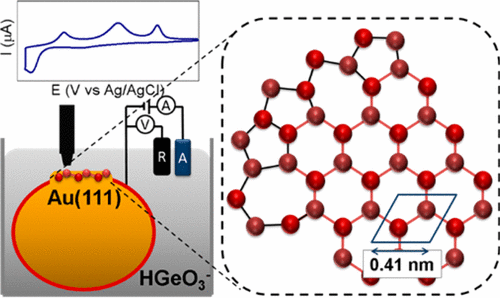Our official English website, www.x-mol.net, welcomes your feedback! (Note: you will need to create a separate account there.)
Electrochemical Scanning Tunneling Microscopic Study of the Potential Dependence of Germanene Growth on Au(111) at pH 9.0
ACS Nano ( IF 17.1 ) Pub Date : 2017-09-14 00:00:00 , DOI: 10.1021/acsnano.7b05236 Nhi N. Bui 1 , Maria Ledina 1 , Theodore J. Reber 1 , Jin Jung 1 , John L. Stickney 1
ACS Nano ( IF 17.1 ) Pub Date : 2017-09-14 00:00:00 , DOI: 10.1021/acsnano.7b05236 Nhi N. Bui 1 , Maria Ledina 1 , Theodore J. Reber 1 , Jin Jung 1 , John L. Stickney 1
Affiliation

|
Germanene is a 2D material whose structure and properties are of great interest for integration with Si technology. Preparation of germanene experimentally remains a challenge because, unlike graphene, bulk germanene does not exist. Thus, germanene cannot be directly exfoliated and is mostly grown in ultrahigh vacuum. The present report uses electrodeposition in an aqueous HGeO3– solution at pH 9. Germanene deposition has been limited to 2–3 monolayers, thus greatly restricting many applicable characterization methods. The in situ technique of electrochemical scanning tunneling microscopy was used to follow Ge deposition on Au(111) as a function of potential. Previous work by this group at pH 4.5 suggested germanene growth, but no buffer was used, resulting in change in surface pH. The addition of borate buffer to create pH 9.0 solution has reduced hydrogen formation and stabilized the surface pH, allowing systematic characterization of germanene growth versus potential. Initial germanene nucleated at defects in the Au(111) herringbone (HB) reconstruction. Subsequent growth proceeded down the face-centered cubic troughs, slowly relaxing the HB. The resulting honeycomb (HC) structure displayed an average lattice constant of 0.41 ± 0.06 nm. Continued growth resulted in the addition of a second layer on top, formed initially by nucleating around small islands and subsequent lateral 2D growth. Near atomic resolution of the germanene layers displayed small coherent domains, 2–3 nm, of the HC structure composed of six-membered rings. Domain walls were based on defective, five- and seven-membered rings, which resulted in small rotations between adjacent HC domains.
中文翻译:

锗对pH 9.0时Au(111)生长的电位依赖性的电化学扫描隧道显微镜研究
锗烯是一种2D材料,其结构和特性对于与Si技术集成非常感兴趣。实验上锗的制备仍然是一个挑战,因为不像石墨烯,不存在本体锗。因此,锗烯不能直接剥落,而大多在超高真空下生长。在水性HGeO本报告用途的电沉积3 -溶液在pH为9 Germanene沉积已不限于2-3单层,从而大大限制的许多适用的表征方法。在原位电化学扫描隧道显微镜技术被用来跟踪Ge在Au(111)上的沉积与电势的关系。该小组先前在pH 4.5上的工作表明锗烯会生长,但未使用缓冲液,导致表面pH值发生变化。添加硼酸盐缓冲液以生成pH 9.0溶液,减少了氢的形成并稳定了表面pH,从而可以系统地表征锗烯的生长与潜在的。初始锗烯在Au(111)人字形(HB)重建缺陷中成核。随后的生长沿面心立方槽继续进行,使HB缓慢松弛。所得的蜂窝(HC)结构显示出0.41±0.06 nm的平均晶格常数。持续增长导致在顶部增加了第二层,该第二层最初是通过围绕小岛形核并随后进行横向2D生长而形成的。锗层的接近原子分辨率显示出由六元环组成的HC结构的小相干域(2-3 nm)。畴壁是基于有缺陷的五元和七元环,这导致相邻的HC域之间的旋转很小。
更新日期:2017-09-15
中文翻译:

锗对pH 9.0时Au(111)生长的电位依赖性的电化学扫描隧道显微镜研究
锗烯是一种2D材料,其结构和特性对于与Si技术集成非常感兴趣。实验上锗的制备仍然是一个挑战,因为不像石墨烯,不存在本体锗。因此,锗烯不能直接剥落,而大多在超高真空下生长。在水性HGeO本报告用途的电沉积3 -溶液在pH为9 Germanene沉积已不限于2-3单层,从而大大限制的许多适用的表征方法。在原位电化学扫描隧道显微镜技术被用来跟踪Ge在Au(111)上的沉积与电势的关系。该小组先前在pH 4.5上的工作表明锗烯会生长,但未使用缓冲液,导致表面pH值发生变化。添加硼酸盐缓冲液以生成pH 9.0溶液,减少了氢的形成并稳定了表面pH,从而可以系统地表征锗烯的生长与潜在的。初始锗烯在Au(111)人字形(HB)重建缺陷中成核。随后的生长沿面心立方槽继续进行,使HB缓慢松弛。所得的蜂窝(HC)结构显示出0.41±0.06 nm的平均晶格常数。持续增长导致在顶部增加了第二层,该第二层最初是通过围绕小岛形核并随后进行横向2D生长而形成的。锗层的接近原子分辨率显示出由六元环组成的HC结构的小相干域(2-3 nm)。畴壁是基于有缺陷的五元和七元环,这导致相邻的HC域之间的旋转很小。



























 京公网安备 11010802027423号
京公网安备 11010802027423号